http://www.rhci-online.net/radiogram/radiogram.htm
RSID: <<2019-03-
http://www.rhci-online.net/radiogram/radiogram.htm
RSID: <<2019-03-
02T13:30Z MFSK-64 @ 11600000+1500>>
Greetings from the Winter SWL Fest in Plymouth Meeting,
Pennsylvania, where I hope to sell my Drake SPR-4 receiver,
purchased in 1970 ...
Sending Pic:143x79C;
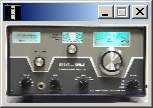
See bit.ly/2XntHxS
Please report decode to
themightykbc@gmail.com
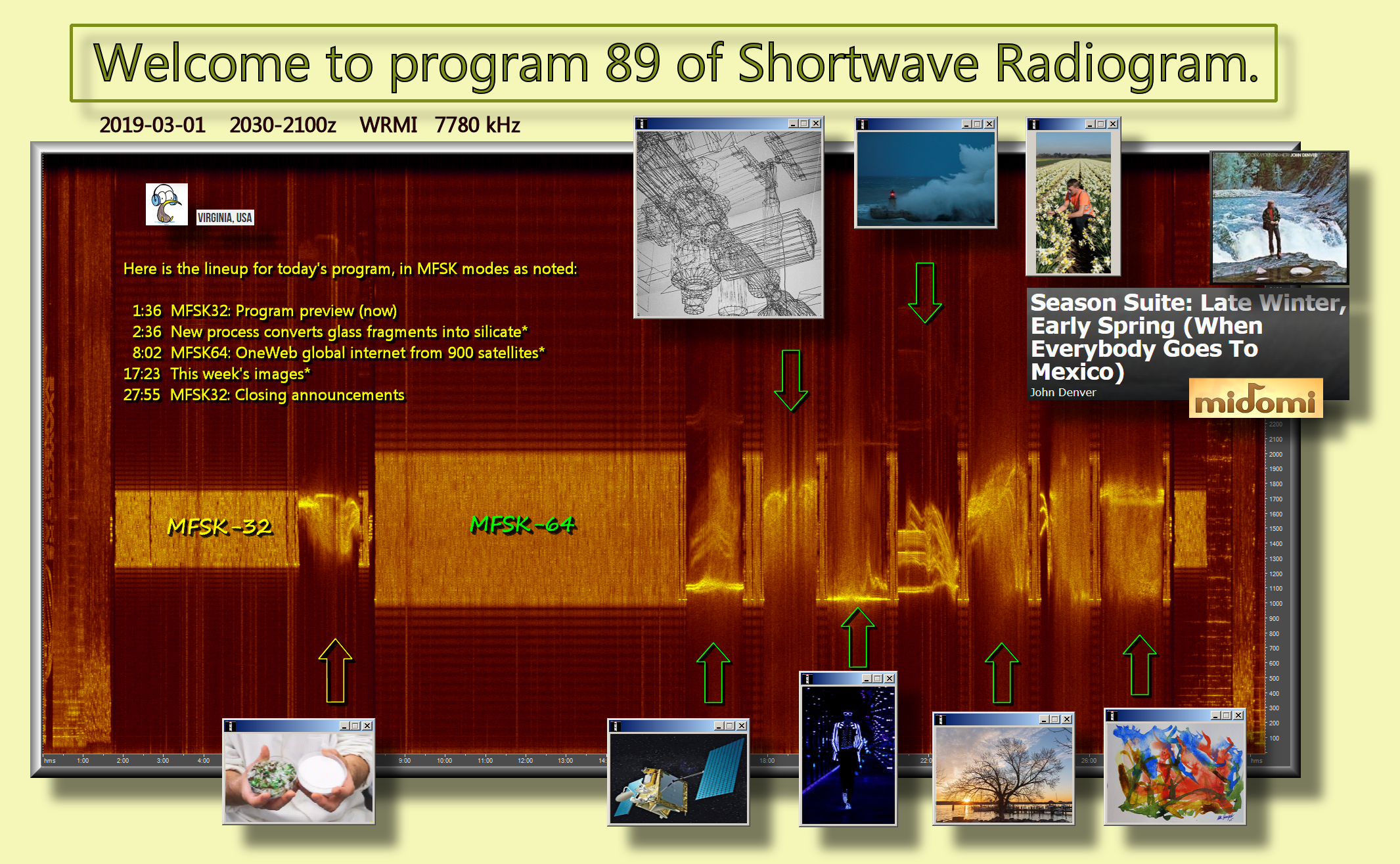
RSID: <<2019-03-
01T20:31Z MFSK-32 @ 7780000+1500>>
From New Atlas:
New process converts unrecyclable glass into saleable product
Ben Coxworth
22 February 2019
Although glass is recyclable, the recycling process is generally
limited to large pieces that can be easily sorted by color.
Because it's not worth the effort to sort smaller fragments, they
tend to simply be discarded. A new process, however, can convert
them into a useful substance.
The proprietary technique was developed by PhD candidate Rhys
Pirie and Prof. Damien Batstone, both of Australia's University
of Queensland. It incorporates what is described as "a chemical
that most people would know as drain cleaner," which is used to
dissolve miscellaneous glass fragments into liquid silicate.
That liquid can subsequently be used in a wide variety of
products, such as tires, detergents, toothpaste, concrete sealant
and even crop fertilizer. It's also utilized to make silica gel,
which is the desiccant contained in little packets with
electronic devices. It cannot, however, be made into new glass on
a commercial scale.
Because glass consists of around 70 to 75 percent silica – which
is what gets converted to liquid silicate – the process results
in little waste. According to Pirie, approximately 1.3 kg (2.9
lb) of waste glass is required to make 1 kg of silica gel.
The technique also requires relatively little energy, unlike
traditional methods of producing liquid silicate. Partially
because of this, the researchers estimate that their process is
over 50 percent cheaper than existing production systems.
"At the moment these kinds of silicates [...] are generated
through a glass production route where you make glass effectively
and you then turn it into a silicate product that is a soluble
gel-type product," says Batstone. "Instead of doing that, we're
going to take glass that has already been made and is actually
waste, and take it through a much simpler process to turn it into
this commercial silicate product."
The university's commercialization company, UniQuest, is now
seeking partner companies that are interested in taking the
technology to market.
Source: University of Queensland
https://newatlas.com/glass-recycling-liquid-silicate/58604/
Image: Glass dishes containing waste glass and the silicate end
product ...
Sending Pic:224x134C;
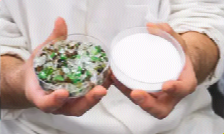
Shortwave Radiogram now changes to MFSK64 ...
RSID: <<2019-03-01T20:38Z
MFSK-64 @
7780000+1500>>
This is Shortwave Radiogram in MFSK64
Please send your reception report to
radiogram@verizon.net
From Deutsche Welle:
OneWeb of 900 internet satellites in space
It's one planet, a mega-constellation of satellites, one web.
Like internet for everyone, anywhere. Sounds great. Right?
Zulfikar Abbany
26 February 2019
The idea is simple: Get everyone on the planet on the internet.
And there's a US-based company called OneWeb, which, along with
European aerospace firm Airbus, hopes to achieve just that. It's
not the first or even the only one to try it. But OneWeb is the
first to get so far.
After starting up seven years ago, the company is finally
starting to launch a fleet of about 900 satellites into a
low-Earth orbit. That's closer to Earth than most communications
satellites and one reason why the network might actually work,
with "better web performance," as the company puts it.
Low-Earth orbit (LEO) is typically up to an altitude of 1,000
kilometers (621 miles). For comparison, the International Space
Station orbits at about 400 km, while other satellites in LEO
tend to be for Earth observation and military purposes. Most
telecommunications satellites fly twice as high in medium
low-Earth orbit (MEO), or even higher at geostationary Earth
orbit (GEO).
Why bother?
Not that it's an impeccable source ... but allow me to quote Mark
Zuckerberg as played by Jesse Eisenberg in the 2010 movie "The
Social Network."
Zucker/Eisenberg says: "Let me tell you the difference between
Facebook and everybody else — We. Don't. Crash. Ever."
It's a simple line, and while perhaps not entirely true, it's one
that underscores the power of Facebook and the power of our
digital age as a whole.
We don't ever want to crash. Increasingly, we can't afford to
crash. We don't ever want to be offline. Because when we are
offline, we're lost. We've come to expect an "ubiquitous
internet" so we can stream films, order drugs like pizza, and
share selfies with Sumatran Tigers, or random acts of teenage
violence from any phone, anywhere.
But here's the thing: The internet is not everywhere.
There are huge plots of the globe where hopping online is a
dream, and patchy connectivity and total outages are the
nightmares of everyday life. In fact, in some cases, being
offline is worse than a nightmare — it's deadly. Think rescue
workers trying to locate survivors after earthquakes, and getting
information to those who need it, fast.
OneWeb lists the following use cases:
Assured global communications in
"sudden
infrastructurerisis," hurricanes,
earthquakes and refugee
situations
Low-latency broadband to "expand"
in-flight connectivity
Vehicle cell network for first
responders
Access to health centers, schools,
libraries, and homes
through a low cost user terminal,
"ensuring relief to
communities in need, tools to drive
education, access to
knowledge, and opportunities for
local businesses"...
And under the heading "building a
neutral network," the
company says its small cell terminals
and core network will
... allow OneWeb to work together
with providers in any
regulatory environment, anywhere in
the world.
Sounds great.
But, erm, what exactly does "any regulatory environment" mean?
First, let's take a step back. Some of us may not even wish to be
online ... churlish, curmudgeons who refuse to fit in with the tech
industry's turbo-charged capitalism ... they're luddites, letting
the team down, right? Either that or we, the great unwashed,
ungrateful West, will say in our infinite arrogant wisdom that
"they" have nothing to fight for, or that they're plain
freedom-haters.
Where's Kris Kristofferson when you need him?*
But, hey, no.
A single, global internet is for the good of everyone. Surely. No
matter what you want it for. And it'll be free of any earthly
challenges, such as sharks biting into submarine, trans-Pacific
telecommunications cables, or our having to dig up remote desert
landscapes in Sub-Saharan Africa, or even Australia.
Isn't that what we mean by environment? Some.
The environment — as in the ground beneath our feet and the air
we breathe — does indeed play a role in space, because even
internet satellites will still have to beam our films and social
media movement back down to Earth, and satellites hate cloud
cover as much as the next paranoid android.
Plus, we'll need a dish or receiver on the ground to pick up
those signals. OneWeb's "user terminals" are apparently good for
3G, LTE and W-iFi connectivity.
But the airwaves are dogged by interference, so it begs the
question: Why not just lay a cable, instead of taking a detour
through space?
Well, some countries won't let you. And that brings us to
regulatory environments. And why OneWeb may be clever to refer
specifically to any regulatory environments.
Because before we all start shooting hoops of joy, thinking
OneWeb solves everything for the digitally oppressed of China or
North Korea, the good money is on China blocking foreign
satellite internet signals. No large power on this planet is
above the use of jamming technology — in case you've never heard
of it, jamming technology does what's written on the tin, it jams
or blocks signals.
And China's testing jammers now.
Oh, and did we mention that the US and Russia are in on it, too?
Infographic showing how space debris can damage a satellite
That's not to mention the fact that China has business interests
to protect: Current indications suggest that China wants to
develop its own broadband satellite constellation in LEO. It
already has satellite customers in Nigeria, Indonesia and
Cambodia.
And as a result, India will also want to flex its network muscles
sometime soon. And the UK.
Russia, meanwhile, has voiced its concern over OneWeb's plans to
bring the internet to remote parts of its country as it
reportedly fears the company's network could be used to gather
intelligence and damage national security.
Vladimir Sadovnikov, a Federal Security official there has been
reported as saying "the only way to address the threats of
foreign satellite networks like OneWeb, especially in the Arctic
region and Far North, is to restrict their usage in Russia."
Whether they do that, or whether they even have the technology to
do that, doesn't really matter. The message is abundantly clear:
Avert your eyes, Five Eyes!**
The business of it all
Russia's message carefully leaves the door open for it to
restrict other foreign networks too, because they will come.
Google has long had its head in the clouds with "Project Loon," a
kind of mesh-network built with hot-air balloons. And Facebook
has had a solar-powered drone project called Aquila. Both, it
seems, could be used as "just-in-time" internet services, dashing
on an ad-hoc basis to where emergency connectivity is required.
But the main contenders are SpaceX, which is already deep in the
satellite-launching business and has space internet plans dubbed
"Starlink," and then there's also Amazon, an online retailer
turned "backend" provider and rocket builder.
Many of America's tech entrepreneurs, like Amazon's Jeff Bezos,
have had life-long interests in space. They went into business
first. But space was a first passion
Amazon's sister company, Blue Origin, builds the rockets, and
just recently signed a deal with Canada's Telesat to launch part
of a satellite constellation. It will aim to provide high-speed
internet access to governments and businesses ... not least its
own.
Aside from its consumer retail business, Amazon's Web Services
(AWS) platform is huge. AWS offers business-level computing
services, including servers and big time analytics. And the
bigger it gets, the less it will want to rely on external
networks.
A bit like Russian and China ...
Ultimately, these networks are about controlling the flow of
information, whether it's for entertainment or saving lives.
All you have to do is ask yourself whether you can trust a
business to deliver a free and open, net neutral internet. Or
whether you think it'll side first and foremost with its
shareholder interests. Those interests may well coincide with
your own, so if you're okay with that, then okay. But if not,
then, Houston ... we truly have a problem.
And not just the one.
Mega debris
Do the math, and you quickly realize that OneWeb's 900 satellites
are just the start.
Amazon and SpaceX will each want to launch hundreds of their own
satellites just to stay in the running, and then China and Russia
will feel they have to add theirs to mix ...
But low-Earth orbit is already over-populated with satellites,
many of which are dead and inoperative. It's pure junk. And while
there are technologies and ideas for how to mitigate a
space-environmental-catastrophe, there's no enforceable law to
have countries or companies remove all their junk. Which is a
problem, because space debris is not just litter, it's also a
potential danger to life and telecommunications.
OneWeb is aware of this "over-crowding" issue, up to a point.
It's developed a "Progressive Pitch" technology, which, says the
company, will allow it to tilt "satellites as they approach the
equator to make sure we never cause, or receive, interference."
Okay, so that's an "uninterrupted" service for you.
As for all that junk, OneWeb says its satellites will deorbit
automatically when they near the end of their "intended service
life."
Two years ago, DW tried to ask OneWeb for details on its
sustainability plans at the European Space Agency's 7th
conference on Space Debris. But they just walked off. That's one
way to say "no comment."
*Kris Kristofferson, American country singer, co-wrote the line:
"Freedom's just another word for nothin' left to lose."
**The Five Eyes intelligence alliance includes Australia, Canada,
New Zealand, the United Kingdom, and the United States.
https://www.dw.com/en/oneweb-of-900-internet-satellites-in-space/a-47690785
Image: Artistic rendering of a OneWeb satellite ...
Sending Pic:208x136C;
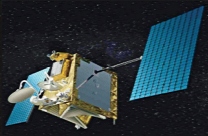
This is Shortwave Radiogram in MFSK64
Please send your reception report to
radiogram@verizon.net
This week's images ...
Detail from the sculpture "Ten Minute Transmission" at the Tate
Gallery in London. The sculpture is the antenna for an amateur
radio transmission. From
bit.ly/2Tc2dfB. And see
bit.ly/2IF1Kyq
...
Sending Pic:281x281;
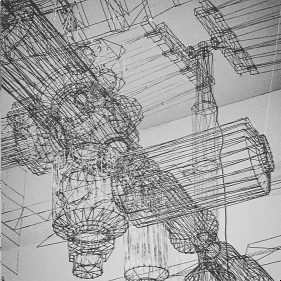
A model presents a creation by designer Anthony Vaccarello during
Paris Fashion Week. From
bit.ly/2SvspNE ...
Sending Pic:141x209C;

Waves crash over Valetta' s Grand Harbor as gale force winds and
rough seas lash Malta.
From bit.ly/2BTzxOC ...
Sending Pic:209x143C;
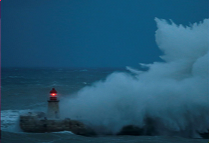
Old Town Alexandria, Virginia, at sunrise. From
wapo.st/2BVez1I
...
Sending Pic:208x145C;

An employee of Taylors Bulbs inspects a crop of daffodils on the
company's farm near Holbeach, England. From
bit.ly/2ThtSM1 ...
Sending Pic:114x215C;
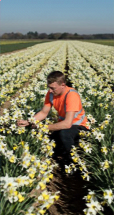
Our painting of the week is "First Signs Of Spring II" bu Ulli
Heupel. From
bit.ly/2SrCScR ...
Sending Pic:208x151C;
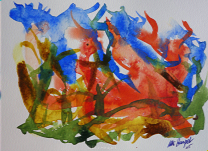
Shortwave Radiogram returns to MFSK32 ...
RSID: <<2019-03-01T20:57Z
MFSK-32 @
7780000+1500>>
This is Shortwave Radiogram in MFSK32 ...
Transmission of Shortwave Radiogram is provided by:
WRMI, Radio Miami International, http://wrmi.net
WINB Shortwave, http://www.winb.com/
and
Space Line, Bulgaria, http://spaceline.bg
Please send reception reports to
radiogram@verizon.net
And visit http://swradiogram.net
Twitter:
@SWRadiogram
I'm Kim Elliott. Please join us for the next Shortwave
Radiogram.
|
Ending song SWRG: https://www.midomi.com/index.php?action=main.track&track_id=100859139481559395&from=voice_search
John Denver - Season Suite: Late Winter, Early Spring (When Everybody Goes To Mexico) https://www.youtube.com/watch?v=ejxA1EurYtQ
|
http://www.rhci-online.net/radiogram/radiogram.htm
|
QTH: |
D-06193 Petersberg (Germany/Germania) |
|
|
Ant.: |
Dipol for 40m-Band & Boomerang Antenna 11m-Band |
|
|
RX for RF: |
FRG-100B + IF-mixer & ICOM IC-R75 + IF-mixer |
|
|
Software IF: |
con STUDIO1 - Software italiano per SDR [S-AM-USB/LSB] + beta 11 Version 2.80 (August 21, 2018) - for scheduled IF-recording |
|
|
Software AF: |
Fldigi-4.0.18 + flmsg-4.0.7 images-fldigifiles on homedrive.lnk |
|
|
OS: |
German XP-SP3 with support for asian languages |
German W7 32bit + 64bit |
|
PC: |
MEDION Titanium 8008 (since 2003) [ P4 - 2,6 GHz] |
MSI-CR70-2MP345W7 (since2014) [i5 -P3560 ( 2 x 2,6GHz) ] |
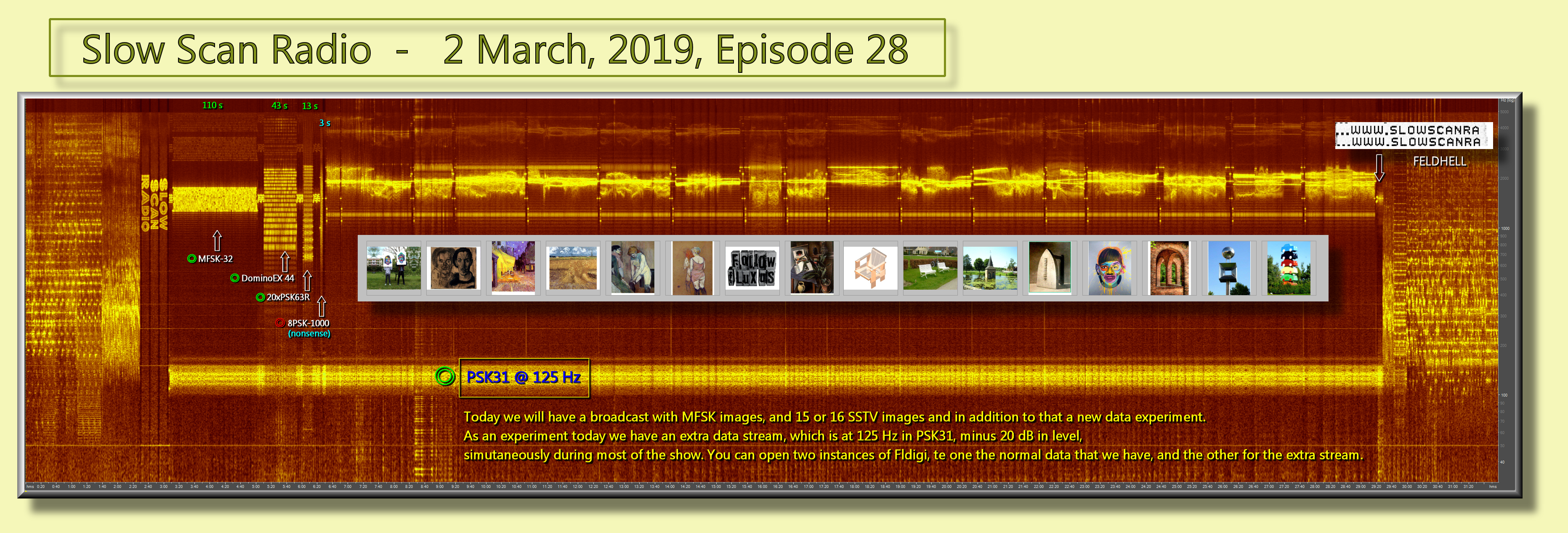

RSID: <<2019-03-02T13:03Z
MFSK-32 @
6070000+1500>>
Slow Scan Radio 2 March, 2019, Episode 28
Good afternoon to everyone listening, reading and watching.
Today we will have a broadcast with MFSK images, and 15 or 16 SSTV images and in
addition to that a new data experiment.
Fldigi and SSTV must have autoswitching on.
As an experiment today we have an extra data stream, which is at 125 Hz in
PSK31, minus 20 dB in level, simutaneously during most of the show. You can open
two instances of Fldigi, te one the normal data that we have, and the other for
the extra stream.
The normal data still will be auto switching, for that reason you might want to
switch ¨RxID¨ in the Fldigi window off for the the second stream (and don’t
forget to switch it on again when you are ready receiving the show!)
I am curious about reception of this stream. If it is successful we can try
improving it a bit more, for example by using Olivia or Contestia for the second
stream, which makes it possible to lower the level of the extra data to more
than minus 30 dB.
Info on the show:
Mail: x@xdv.me
Web: www.slowscanradio.com
Mastodon: @PA0ETE@wokka.be
Twitter: @SlowScanRadio
Slow Scan Radio is sponsored by 70MHzshop.nl
de k
RSID: <<2019-03-02T13:05Z
DominoEX 44 @
6070000+1500>>
Slow Scan Radio 2 March, 2019, Episode 28
Good afternoon to everyone listening, reading and watching.
Today we will have a broadcast with MFSK images, and 15 or 16 SSTV images and in
addition to that a new data experiment.
Fldigi and SSTV must have autoswitching on.
As an experiment today we have an extra data stream, which is at 125 Hz in
PSK31, minus 20 dB in level, simutaneously during most of the show. You can open
two instances of Fldigi, te one the normal data that we have, and the other for
the extra stream.
The normal data still will be auto switching, for that reason you might want to
switch ¨RxID¨ in the Fldigi window off for the the second stream (and don’t
forget to switch it on again when you are ready receiving the show!)
I am curious about reception of this stream. If it is successful we can try
improving it a bit more, for example by using Olivia or Contestia for the second
stream, which makes it possible to lower the level of the extra data to more
than minus 30 dB.
Info on the show:
Mail: x@xdv.me
Web: www.slowscanradio.com
Mastodon: @PA0ETE@wokka.be
Twitter: @SlowScanRadio
Slow Scan Radio is sponsored by 70MHzshop.nl
de k
RSID: <<2019-03-02T13:06Z
20xPSK63R @
6070000+1500>>
Slow Scan Radio 2 March, 2019, Episode 28
Good afternoon to everyone listening, reading and watching.
Today we will have a broadcast with MFSK images, and 15 or 16 SSTV images and in
addition to that a new data experiment.
Fldigi and SSTV must have autoswitching on.
As an experiment today we have an extra data stream, which is at 125 Hz in
PSK31, minus 20 dB in level, simutaneously during most of the show. You can open
two instances of Fldigi, te one the normal data that we have, and the other for
the extra stream.
The normal data still will be auto switching, for that reason you might want to
switch ¨RxID¨ in the Fldigi window off for the the second stream (and don’t
forget to switch it on again when you are ready receiving the show!)
I am curious about reception of this stream. If it is successful we can try
improving it a bit more, for example by using Olivia or Contestia for the second
stream, which makes it possible to lower the level of the extra data to more
than minus 30 dB.
Info on the show:
Mail: x@xdv.me
Web: www.slowscanradio.com
Mastodon: @PA0ETE@wokka.be
Twitter: @SlowScanRadio
Slow Scan Radio is sponsored by 70MHzshop.nl
de k
RSID: <<2019-03-02T13:06Z
8PSK-1000 @
6070000+1500>>
kocsd we wils btw ta bo etdcaan eithmeFSKoûuies,etncÛ2 or en WxTne imsces ind in
SdJªn 7 that ajew data ¼aerim3t.
v Fldigi indexSTV rzanxlPee¼ewitcI ng o8
As a Îj° ut today[e btwe @ka data streafI khicieiseL uÒgaHzo nxKa, m£us to, dj
lrnelI siriieousfu nzring most ofyheeih ae. You ctu l u two £sitncealcifisat
tonzthpnormas w/txbL
we?a÷saind thŒtherehor ¥Îp anro ²v
The normal w/t stiul will±e auto switikinwsab satbL reas y mez mot want
toeiwitch Âcxh^§o n therildigi wind ae 5f femyhe thUeec pd anro rwtnd conâ !lon
b ,g n t yewitchox p agaia[henni
ou areadg r qeivong thjih ae!½v i
j amAzri As ab t!Âephkc 5oOiseitr3oÈüa4nMs axiqessbqn we cii tor[mt r ah ngxnn
btn° ,esab sXxam t~ hrÞsicc 0T via oroôntestia femeei qo s£eam, which makesxn
psiiobei aeeryheei s 5
thyra data to moreyhin rcnu33j
hpfo &Moe si d¿Æ,
Hhi/ m ,3dv.feeie£s hþe²is aesktnraOk:qomË,Masd d y: ,cc#5q£drcug-be
Twitter-e8Sl aoxcikctqi `=1þSc@ Rad© isehco or*ked !Izfo lr jl
|
Various & Gould sind ein in Berlin ansässiges Künstler-Duo. Ihre Namen nennen die Frau und der Mann nicht. Various & Gould arbeiten seit 2005 als Duo zusammen. Im Jahr 2010 schlossen sie ihr Studium an der Kunsthochschule Berlin-Weißensee ab und erwarben ihr Diplom bei Alex Jordan.
|
https://www.museumarnhem.nl/pers/persberichten-en-downloads/dick-ket-magisch-tekenaar/ Vanaf 17 september 2016 presenteert Museum Arnhem de tentoonstelling Dick Ket. |
https://nl.wikipedia.org/wiki/Vincent_van_Gogh Caféterras bij nachtCaféterras bij nacht, ook bekend als Terrasse du café le soir, Place du forum, Arles, is een schilderij van de Nederlandse kunstschilder Vincent van Gogh dat hij in september 1888 in de Franse stad Arles maakte. Het schilderij bevindt zich in het Kröller-Müller Museum in Otterlo.
|
https://nl.wikipedia.org/wiki/Vincent_van_Gogh Wheat_Field,_June_1888,_Oil_on_canvas.jpg Wheatfield with sheaves of grain Weizenfeld mit Getreibegarben
|
|
|
|
|
|
|
https://en.wikipedia.org/wiki/Henri_de_Toulouse-Lautrec https://de.wikipedia.org/wiki/Henri_de_Toulouse-Lautrec junge_frau_beim_anziehen_des_strumpfes
|
https://en.wikipedia.org/wiki/Henri_de_Toulouse-Lautrec https://de.wikipedia.org/wiki/Henri_de_Toulouse-Lautrec Two-Half-Naked-Women-Seen-From-Behind-In-The-Rue-Des-Moulins-Brothel.html |
https://commons.wikimedia.org/wiki/File:Follow_Fluxus_Logo.jpg Follow Fluxus – Fluxus und die Folgen Das Stipendium Follow Fluxus – Fluxus und die Folgen wird seit 2008 jährlich von der Landeshauptstadt Wiesbaden und dem Nassauischen Kunstverein Wiesbaden (NKV) vergeben. http://www.wiesbaden.de/kultur/bildende-kunst/preise-stipendien/stipendium-follow-fluxus.php
|
https://de.wikipedia.org/wiki/Alexander_Kanoldt https://de.wikipedia.org/wiki/Datei:Alexander_Kanoldt_Still_Life_II.jpg |
|
|
|
|
|
|
https://nl.wikipedia.org/wiki/Gerrit_Rietveld Krat-stoel uit 1934 https://commons.wikimedia.org/wiki/File:Rietveld_kratstoel_001.svg
|
Willy Dobbeplantsoen te Olst https://commons.wikimedia.org/wiki/File:Olst_-_Willy_Dobbeplantsoen.jpg |
https://en.wikipedia.org/wiki/Torentje_van_Drienerlo (located on the campus of the University of Twente in Enschede)
|
/surrealism1/a/man-ray-the-gift Man Ray, Gift, c. 1958 (replica of 1921 original), painted flatiron and tacks, 15.3 x 9 x 11.4 cm (The Museum of Modern Art)
|
|
|
|
|
|
|
|
Impossible_object_(153776153).jpg
|
File:Alcorcón, escultura urbana 01.jpg
Escultura urbana en Alcorcón (Madrid)
|
http://pinkcrossdesign.blogspot.com/2012_03_04_archive.html http://nadia-mingo.blogspot.com/2011/03/ "...Sus creaciones, aparentemente lúdicas, plantean reflexiones más serias como la contradicción ecológica en la que vivimos los países desarrollados, la clonación o el futuro del ser humano...." |
RSID: <<2019-03-02T13:29Z
Feld Hell @
6070000+1500>>
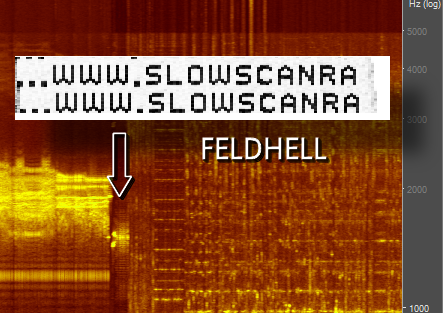
NO RSID:
<<2019-03-02T13:03Z
BPSK31 @
6070000+125>>
(@125
Hz / 27 minutes)
GB2RS NEWS
<=======
https://rsgb.org/main/gb2rs/
Sunday 24th February 2019
The news headlines:
• IARU active at WRC-19 preparation
• Enter the Club of the Year
competition
• Could you be RSGB Company
Secretary?
The ITU Conference Preparation Meeting for WRC-19 has been running this week and
will continue into next week. Taking place in Geneva, the IARU has been present
for Agenda Items on
50MHz, Wireless Power and other matters of importance to amateur radio.
There is still time to put in an entry for the RSGB Club of the Year
competition. Entries are welcome from all RSGB affiliated groups, and there is
just one size category this year so
the size of your club doesn’t matter. The theme is ‘Meeting RSGB Strategy 2022’.
Entries must be received by the 28th of February. Clubs should read the rules at
www.rsgb.org/main/clubs/
national-club-of-the-year/ and send entries to their Regional Representative.
The RSGB would like to thank Waters & Stanton for their continued sponsorship of
this competition.
The RSGB looking to recruit an RSGB Member to the voluntary position of Company
Secretary. The position plays a key role in the Society’s governance and
provides vital support in the
running of Board meetings and the Annual General Meeting. For full information
on the role, please go to www.rsgb.org/volunteers. If you feel you have the
necessary skills to fulfil this
important role, or would like more information, email the Chairman of the Board
via chairman@rsgb.org.uk and if you are applying for the position, please
include a current CV.
For the first couple of days after KickSat-2 was deployed last November, nothing
was heard from the satellite. But in February, Nico, PA0DLO reported receiving
several short and weak
telemetry bursts on 437.5077MHz. KickSat-2 was scheduled to deploy up to 104
tiny Sprite satellites into low Earth orbit. The Sprites then would transmit on
437.240MHz at 10mW. The
Sprites, which are less than 2 square inches, are expected to re-enter Earth’s
atmosphere within weeks. There is no news on whether these Sprites will be
deployed.
Provisional results for the last IARU Region 1 50 to 70MHz Contest are now
available on the IARU Region 1 website, www.iaru-r1.org. Several UK stations are
in the top ten in various
categories. The 6 hour 50MHz category saw G4ZAP/P achieving 4th place and
G0VHF/P got 10th place. In the multi-operator 50MHz section, the GJ8P stations
achieved 5th place.
The ARRL has released version 11.7 of the Logbook of the World configuration
file. This has added the ability to confirm QSOs made through the JO-97, FO-99
and QO-100 satellites. Users
should receive a prompt to update their configuration file when opening recent
versions of TQSL. The file can also be downloaded from
https://lotw.arrl.org/lotwuser/config.tq6
The RSGB has changed the way it hosts the online version of RadCom. This uses
HTML5 to display the pages and no l nger requires Flash to be installed. Pages
will also load faster. All
this year’s editions are now available to Members in the new format at
www.rsgb.org/radcom and we will be converting back issues from previous years in
due course.
Car parking charges will be waived for The West of England Radio Rally on 16
June at Frome’s Cheese and Grain. Last year, Mendip District Council introduced
Sunday charges in a number of
car parks across Frome, including the exhibitors’ site. According to BBC News,
the council has announced it will stop charging for the duration of the event.
And now for the details of rallies and events for the coming week
Today, the 24th, the Rainham Radio Rally takes place at The Victory Academy,
Magpie Hall Road, Chatham, Kent, ME4 5JB. Doors open 10am to 4pm and it’s £2.50
for adults, with free entry
for children. There will be local and national traders, the BRATS kitchen, a
BRATS Interactive Zone for Kids, BRATS Junk and a Talk-in Station on 145.550MHz
using GB4RRR.
Also today, the 24th, the Red Rose Rally will be held at St Josephs Hall, Chapel
Street, Leigh WN7 2PQ. Doors open at 11am. There will be trade, individual and
club stands, including an
RSGB bookstall, as well as a Bring & Buy. Catering will be available on site.
Details are at www.wmrc.co.uk.
Next Sunday, the 3rd of March, the Exeter Radio & Electronics Rally takes place
at America Hall, De la Rue Way, Pinhoe, Exeter EX4 8PW. Doors open at 10.30am,
with disabled customers
gaining access at 10.15am. Admission is £2, with under 16s free. There will be
trade stands, a Bring & Buy, and catering will be available on site. Details
from Pete, G3ZVI on 0771 419
8374.
To get your event into RadCom, onto GB2RS and on the RSGB website, please send
details as early as possible to radcom@rsgb.org.uk – we need to know about four
months in advance for
RadCom.
And now the DX news from 425 DX News and other sources
George, W2AIV will be on holiday in Belize as V31GF until the 2nd of March. He
will be on the 40, 20, 15 and 10m bands using SSB but will also try some slow CW.
Logs will be uploaded to
Logbook of The World.
Willy, ON4AVT will be active as 6W7/ON4AVT from Senegal until the 30th of March.
He will operate PSK, CW, SSB and possibly FT8 on various bands including 60m.
QSL via his home call,
bureau preferred.
Roman, UT7UA is active as EM1UA and/or EM1U from the Ukrainian Research Station
located on Galindez Island, AN-006, Antarctica. His licence is valid until 1
February 2020. QSL for both
callsigns via UT7UA.
Gildas and Michel will be active as FG/F6HMQ and FG/F6GWV respectively from
Guadeloupe, NA-102, until the 10th of March. QSL via their home calls. In the
ARRL DX SSB Contest they’ll call
TO3Z. QSL via F6HMQ.
Arnaud, JG1XMV will be on the air as FK/JG1XMV from New Caledonia until the 10th
of March. He will operate SSB on the 40 to 15m bands from the main island,
Grande Terre, OC-032. Updates
will be posted on QRZ.com under FK/JG1XMV. QSL via JG1XMV either direct or the
bureau, Logbook of The World and eQSL.
Now the special event news
H31A is being used to commemorate 500 years of the foundation of Panama City,
Panama. The station will be on the air at various times until the 15th of
August. They will be operating on
the 80 to 10m bands, particularly using digital modes, RTTY, PSK31 and FT8, and
some SSB. For more information, please refer to QRZ.com. The QSL manager is
HP1AVS.
Please send special event details to radcom@rsgb.org.uk, as early as possible,
for free publicity on GB2RS, in RadCom and online. Remember that UK stations
with special event callsigns
must be open to the public, so our free publicity can help make your efforts
more widely known.
Now the contest news
Today, the 24th, the First 70MHz Cumulative Contest runs from 1000 to 1200UTC.
Using all modes, the exchange is signal report, serial number and locator.
The CW World Wide 160m DX contest ends its 48 hour run at 2200UTC today, the
24th. Using SSB on the 1.8MHz band only, the exchange is signal report and CQ
Zone, which for the UK is 14.
American and Canadian stations will also send their State or Province.
The REF Contest ends today at 1800UTC. Using SSB only on the 3.5 to 28MHz
contest bands, the exchange is signal report and serial number. French stations
also send their département
number or overseas prefix.
On Tuesday the SHF UK Activity Contest runs from 1930 to 2230UTC. Using all
modes on the 2.3 to 10GHz bands, the exchange is signal report, serial number
and locator.
On Wednesday the UK and Ireland Contest Club 80m contest runs from 2000 to
2100UTC. This is a CW leg and the exchange is your 4-characeoCee‚t
ßen Ttursdey tCte cl ags. uOtmpioo ehieo
ses rs CatHt
from:
https://rsgb.services/public/gb2rs/gb2rs_news_script_24_02_2019.doc
https://soundcloud.com/thisisamusicshow/002-off-air-feb-28-2019
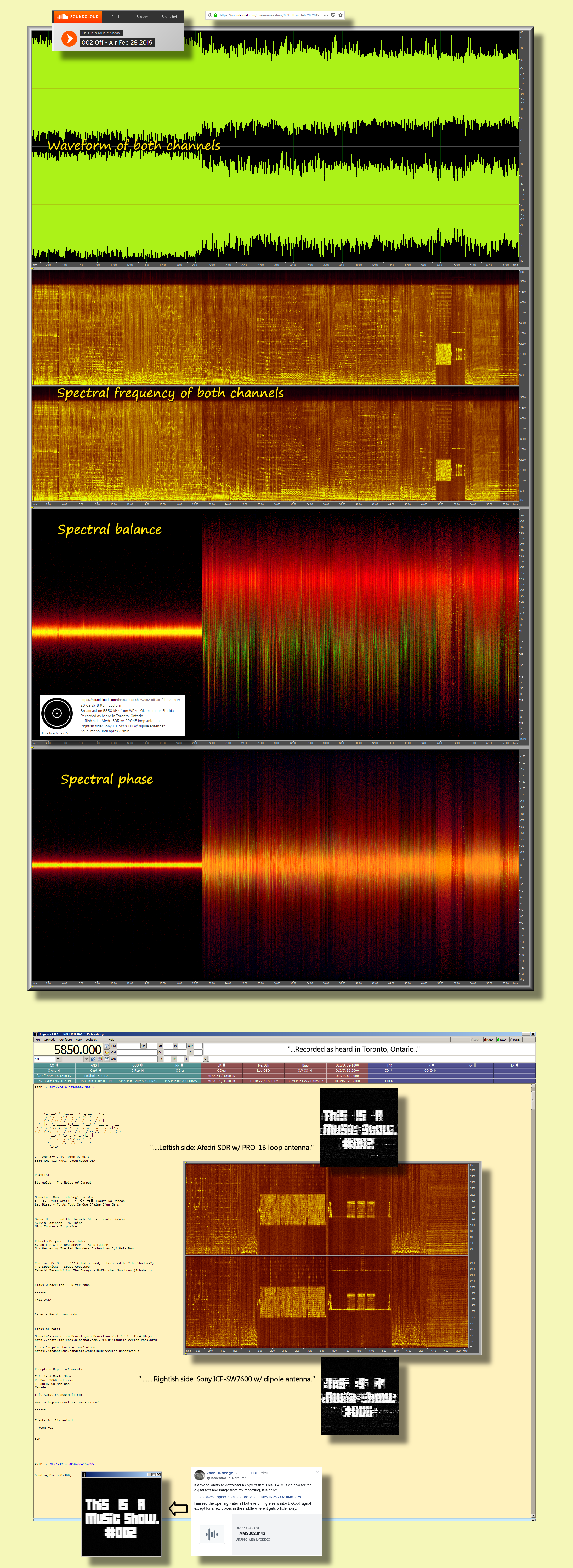
28 February 2019 0100-0200UTC
5850 kHz via WRMI, Okeechobee USA
----------------------------------------
PLAYLIST
Stereolab - The Noise of Carpet
------
Manuela - Mama, Ich Sag' Dir Was
荒井由実 (Yumi Arai) - ルージュの伝言 (Rouge No Dengon)
Les Bises - Tu As Tout Ce Que J'aime D'un Gars
------
Oscar Harris and the Twinkle Stars - Wintie Groove
Sylvia Robinson - My Thing
Nick Ingman - Trip Wire
------
Roberto Delgado - Liquidator
Byron Lee & The Dragoneers - Step Ladder
Guy Warren w/ The Red Saunders Orchestra- Eyi Wala Dong
------
You Turn Me On - ????? (studio band, attributed to "The Shadows")
The Spotnicks - Space Creature
Takeshi Terauchi And The Bunnys - Unfinished Symphony (Schubert)
寺内タケシとバニーズ
https://www.midomi.com/index.php?action=main.track&track_id=100929315924644470&from=voice_search
------
Klaus Wunderlich - Dufter Zahn
------
THIS DATA
------
Cares - Resolution Body
----------------------------------------
Links of note:
Manuela's career in Brazil (via Brazilian Rock 1957 - 1964 Blog):
http://brazilian-rock.blogspot.com/2013/05/manuela-german-rock.html
Cares "Regular Unconscious" album
https://andoptions.bandcamp.com/album/regular-unconscious
------
Reception Reports/Comments
This is A Music Show
PO Box 99060 Galleria
Toronto, ON M6H 0B3
Canada
thisisamusicshow@gmail.com
www.instagram.com/thisisamusicshow/
------
Thanks for listening!
--YOUR HOST--
EOM
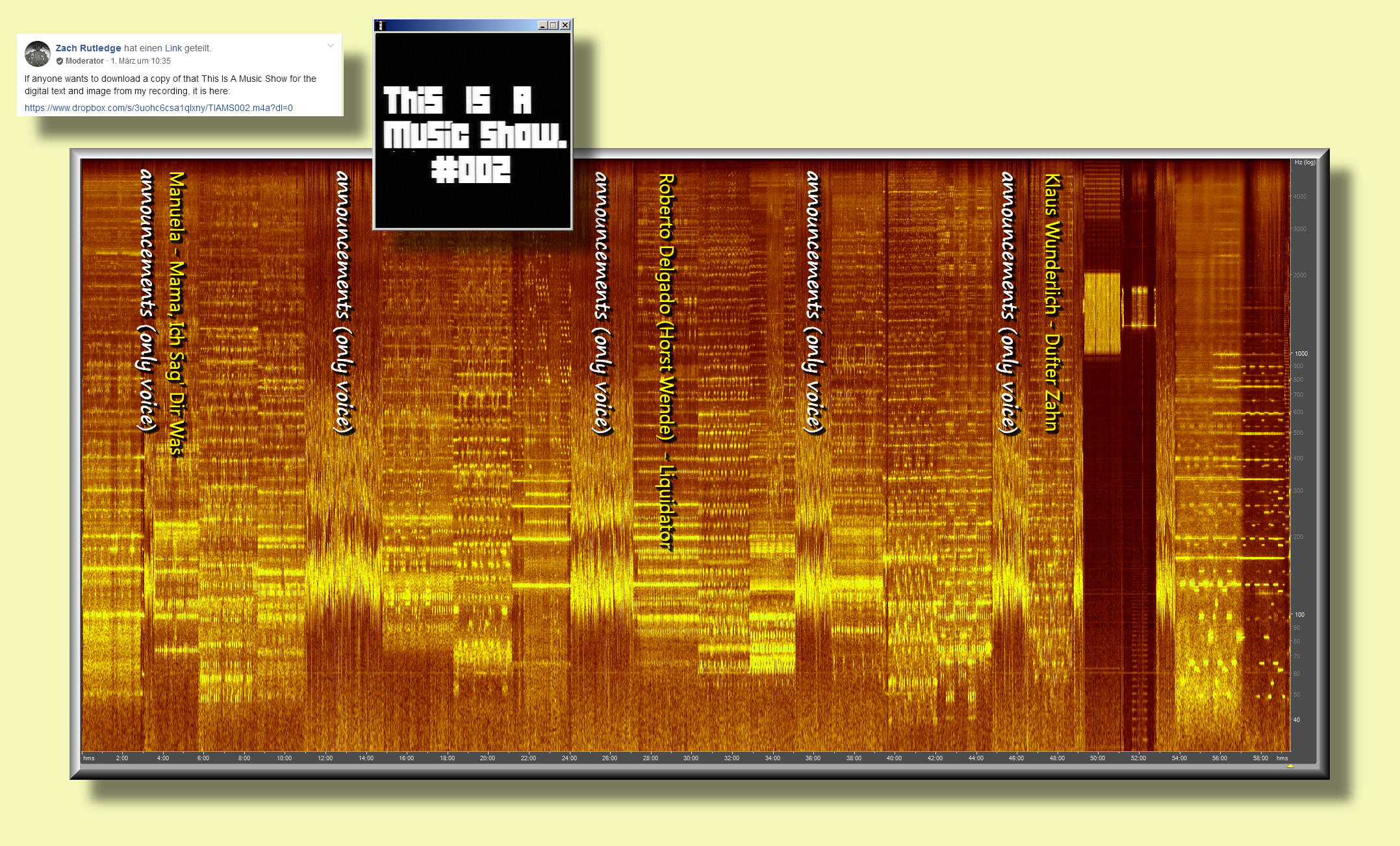
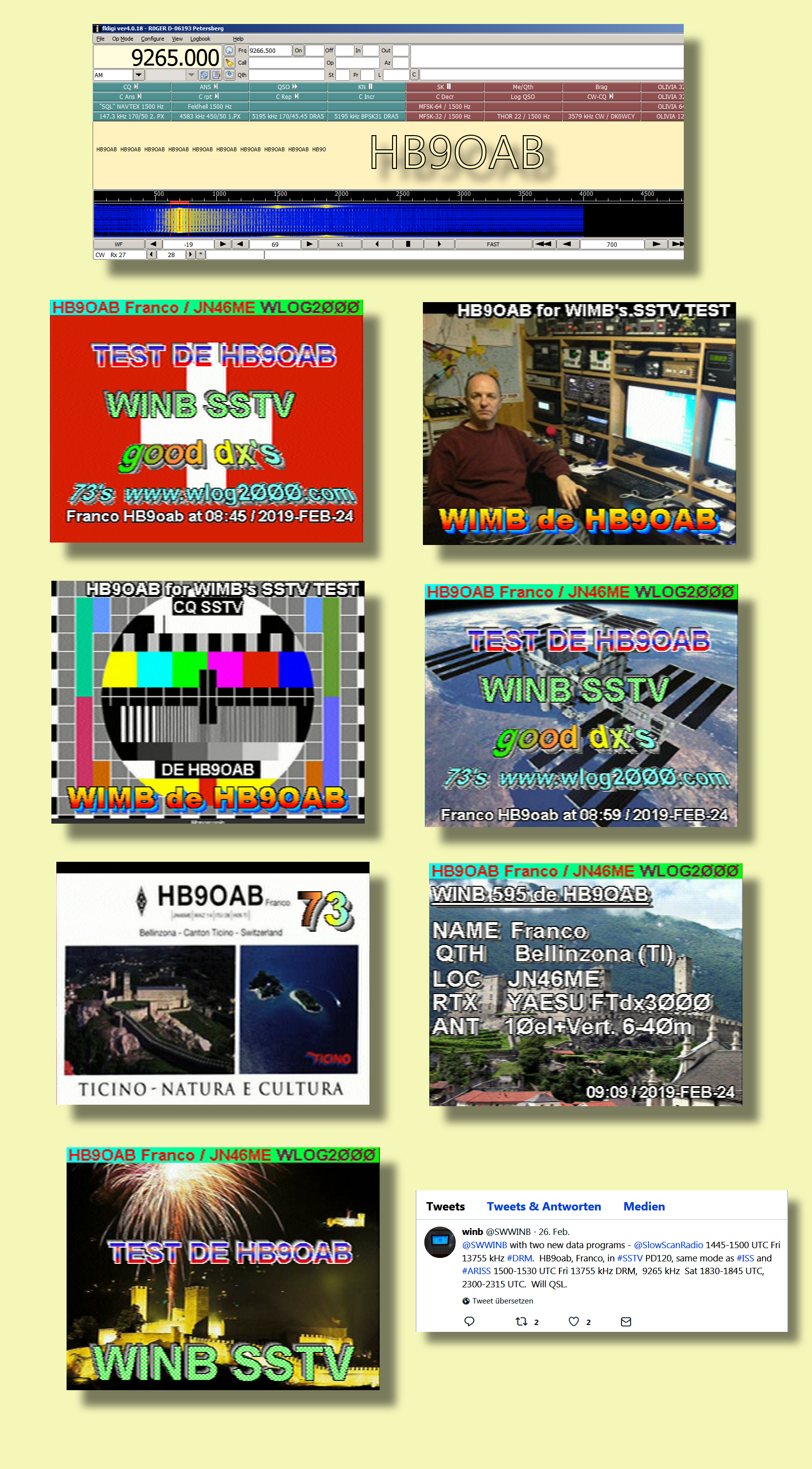
https://www.darc.de/nachrichten/radio-darc/
Sendeplätze von RADIO DARC auf
Bürger-Radios / Offenen Kanälen:
Berlin: „Ohrfunk“ auf 88,4 MHz mit 1 KW und Potsdam 90,7 MHz/100 W, Kabel und Livestream – sonntags 08.00 Uhr Ohrfunk aus Berlin – das Programm von und für blinde und sehbehinderte Menschen
„Radio
Ostfriesland“ auf 94,0 & 87,7 & 103,9 MHz MHz, Kabel und
Livestream – sonntags 14.05 Uhr
Berlin: „Alex Radio“ auf 91,0 MHz mit 0,4 KW, Kabel und Livestream – freitags 15.00 Uhr 14-tägig im Wechsel mit Welle370, dem Funkerbergradio aus Königswusterhausen b. Berlin
Bremen: „Radio Weser.TV Bremen“ auf 92,5 MHz mit 0,2 KW, Kabel und Livestream - sonntags 17.00 Uhr
Bremerhaven „Radio
Weser.TV Bremerhaven“ auf 90,7 MHz mit 0.2 kW, Kabel und
Livestream – freitags 12.00 Uhr
Greifswald: „radio 98eins/NB-Radiotreff 88,0“ auf 98,1 MHz mit 0,2 KW – sonntags 14.00 Uhr und dienstags 16.00 Uhr http://82.193.248.59:8000/radio98eins.mp3
Malchin : „Studio Malchin/NB-Radiotreff 88,0“ auf 98,7 MHz mit 0,1 KW, Livestream - sonntags 14.00 Uhr und dienstags 16.00 Uhr http://82.193.248.59:8000/radio98einsonair
Neubrandenburg: „NB-Radiotreff 88,0“ auf 88,0 MHz mit 0,8 KW, Livestream – sonntags 14.00 Uhr und dienstags 16.00 Uhr http://82.193.248.59:8000/live192
Weimar: „Radio Lotte“ auf 106,6 MHz mit 2 KW, Kabel, Mediathek und Livestream - montags 16.00 Uhr und samstags 18.00 Uhr
Eisenach: „Wartburg-Radio“ auf 96,5 MHz mit 0,2 KW und Livestream - dienstags 21.00 Uhr u freitags 10.00 Uhr
Nordhausen: „Radio Enno“ auf 100,4 MHz mit 0,1 KW, Kabel und Livestream – sonntags 20.00 Uhr und mittwochs 21.00 Uhr
Saalfeld, Rudolstadt, Blankenburg: „Radio SRB“ auf 105,2 MHz mit 0,3 KW und Livestream – mittwochs 22.00 Uhr
Jena: „Radio OKJ“ auf 103,4 MHz mit 0,32 KW, Kabel und Livestream – sonntags 12.00 Uhr
Hamburg: „Tide Radio“ auf 96,0 MHz mit 50 Watt und DABplus mit 4KW, Kabel, Livestream und Mediathek (www.tidenet.de/radio/nachhoeren) – mittwochs 18.00 Uhr
Nordhessen: „RundFunk Meissner“ aus Eschwege auf 96,5 MHz mit 0,32 KW, aus Witzenhausen auf 99,7 MHz mit 0,5 KW und DABplus im Multiplex 6A mit 4 mal 5 KW, sowie im Livestream – sonntags 15.05 Uhr und montags 16.05 Uhr
Graz (Steiermark/Österreich): „Radio Helsinki – Freies Radio GRAZ“ auf 92,6 MHz mit 1KW, Livestream – dienstags 15.00 Uhr
Sendeplätze von RADIO DARC auf Internet-Radios:
Jeden Sonntag 18:00 Uhr MEZ auf dem
Internet-Sender "SATzentrale - Das Radio"
Webseite:
www.satzentrale.de/szradio
Jeden Montag 19:00 Uhr MEZ auf dem Internet-Sender "afu-Webradio"
Jeden Montag 22:00 Uhr MEZ auf dem
Internet-Sender "SVR-Hanseradio" in Stralsund.
Webseite ist
www.svr-hanseradio.de
Jeden Dienstag 22:00 Uhr MEZ auf dem Internet-Sender "Radio 440 Hz"
Jeden Mittwoch 19:00 MEZ auf dem Internet-Sender "Radio Trista" www.radio-trista.de.
Jeden Mittwoch 20:00 Uhr MEZ auf
dem Internet-Sender "SATzentrale - Das Radio"
Webseite:
www.satzentrale.de/szradio
Jeden Donnerstag 18:00 MEZ auf dem Internet-Sender "Radio ISW Plus"
Jeden Donnerstag 19:00 Uhr MEZ auf dem Internet-Sender "afu-Webradio"
Jeden Samstag 19:00 Uhr MEZ auf dem
Internet-Sender "SATzentrale - Das Radio"
Webseite:www.satzentrale.de/szradio
Radio UNICC (Chemnitz) Montag 21.00 Uhr
http://stream.radio-unicc.de:8000/unicc_xq.mp3
https://onlineradiobox.com/de/unicc/playlist/6?cs=de.unicc